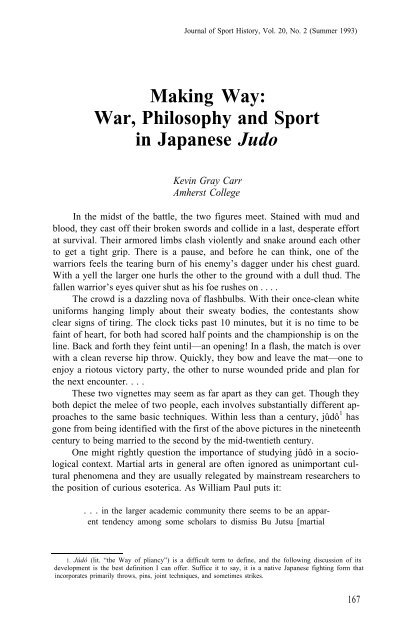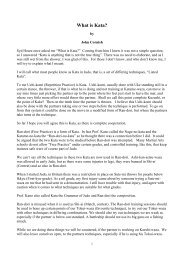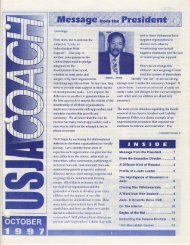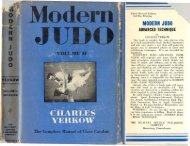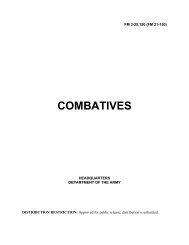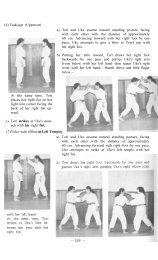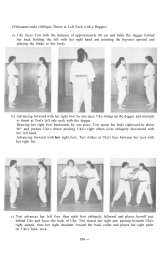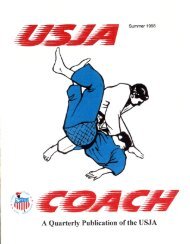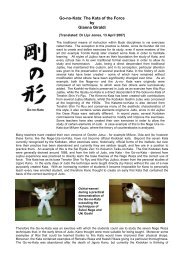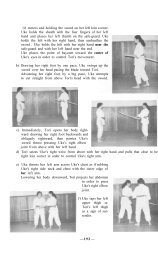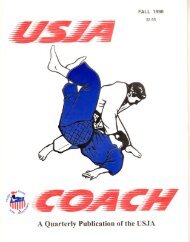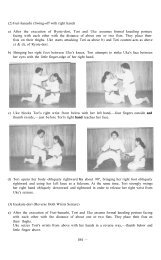Making Way: War, Philosophy and Sport in Japanese Judo
Making Way: War, Philosophy and Sport in Japanese Judo
Making Way: War, Philosophy and Sport in Japanese Judo
You also want an ePaper? Increase the reach of your titles
YUMPU automatically turns print PDFs into web optimized ePapers that Google loves.
Journal of <strong>Sport</strong> History, Vol. 20, No. 2 (Summer 1993)<strong>Mak<strong>in</strong>g</strong> <strong>Way</strong>:<strong>War</strong>, <strong>Philosophy</strong> <strong>and</strong> <strong>Sport</strong><strong>in</strong> <strong>Japanese</strong> <strong>Judo</strong>Kev<strong>in</strong> Gray CarrAmherst CollegeIn the midst of the battle, the two figures meet. Sta<strong>in</strong>ed with mud <strong>and</strong>blood, they cast off their broken swords <strong>and</strong> collide <strong>in</strong> a last, desperate effortat survival. Their armored limbs clash violently <strong>and</strong> snake around each otherto get a tight grip. There is a pause, <strong>and</strong> before he can th<strong>in</strong>k, one of thewarriors feels the tear<strong>in</strong>g burn of his enemy’s dagger under his chest guard.With a yell the larger one hurls the other to the ground with a dull thud. Thefallen warrior’s eyes quiver shut as his foe rushes on . . . .The crowd is a dazzl<strong>in</strong>g nova of flashbulbs. With their once-clean whiteuniforms hang<strong>in</strong>g limply about their sweaty bodies, the contestants showclear signs of tir<strong>in</strong>g. The clock ticks past 10 m<strong>in</strong>utes, but it is no time to befa<strong>in</strong>t of heart, for both had scored half po<strong>in</strong>ts <strong>and</strong> the championship is on thel<strong>in</strong>e. Back <strong>and</strong> forth they fe<strong>in</strong>t until—an open<strong>in</strong>g! In a flash, the match is overwith a clean reverse hip throw. Quickly, they bow <strong>and</strong> leave the mat—one toenjoy a riotous victory party, the other to nurse wounded pride <strong>and</strong> plan forthe next encounter. . . .These two vignettes may seem as far apart as they can get. Though theyboth depict the melee of two people, each <strong>in</strong>volves substantially different approachesto the same basic techniques. With<strong>in</strong> less than a century, jûdô 1 hasgone from be<strong>in</strong>g identified with the first of the above pictures <strong>in</strong> the n<strong>in</strong>eteenthcentury to be<strong>in</strong>g married to the second by the mid-twentieth century.One might rightly question the importance of study<strong>in</strong>g jûdô <strong>in</strong> a sociologicalcontext. Martial arts <strong>in</strong> general are often ignored as unimportant culturalphenomena <strong>and</strong> they are usually relegated by ma<strong>in</strong>stream researchers tothe position of curious esoterica. As William Paul puts it:. . . <strong>in</strong> the larger academic community there seems to be an apparenttendency among some scholars to dismiss Bu Jutsu [martial1. Jûdô (lit. “the <strong>Way</strong> of pliancy”) is a difficult term to def<strong>in</strong>e, <strong>and</strong> the follow<strong>in</strong>g discussion of itsdevelopment is the best def<strong>in</strong>ition I can offer. Suffice it to say, it is a native <strong>Japanese</strong> fight<strong>in</strong>g form that<strong>in</strong>corporates primarily throws, p<strong>in</strong>s, jo<strong>in</strong>t techniques, <strong>and</strong> sometimes strikes.167
Journal of <strong>Sport</strong> History, Vol. 20, No. 2 (Summer 1993)arts] as a curious antiquity which has had a vague <strong>and</strong> unsavoryrelationship to organized violence. 2Thus, there is an unfortunate dearth of good scholarship <strong>in</strong> the field of martialarts. Even so, it may seem that jûdô garners far more attention than it deserves.For Japan is a modern society, <strong>and</strong> the number of <strong>Japanese</strong> jûdôpractitioners who are members of an jûdô organization is less than for baseball,volleyball, basketball, <strong>and</strong> even p<strong>in</strong>g-pong. 3 Nevertheless, we cannot betoo hasty <strong>in</strong> dismiss<strong>in</strong>g the exam<strong>in</strong>ation of this cultural phenomenon.Not only is jûdô especially conspicuous <strong>in</strong> Japan, it is also the only<strong>Japanese</strong> sport to be practiced <strong>in</strong>ternationally on any appreciable scale. 4 In thelast century, it has metamorphosed from a relatively small-scale, rather esoteric“martial art” to a large-scale, modern, Westernized, <strong>and</strong> <strong>in</strong>ternationalsport. The rapidly chang<strong>in</strong>g magnitude, orientation, <strong>and</strong> <strong>in</strong>terpretation of jûdôcan provide us with a fasc<strong>in</strong>at<strong>in</strong>g topic for historical study <strong>and</strong> research, forthe movement reflects the development of chang<strong>in</strong>g cultural attitudes <strong>and</strong>concerns.This paper attempts to show that the idealization of bushi (warriors) is arecent construct. When the modern forms of martial arts were developed, themilitary history of Japan was go<strong>in</strong>g through a profound spiritual revision.That is, it was claimed that the bushi followed a dô, or spiritual path, that<strong>in</strong>timately l<strong>in</strong>ked their fight<strong>in</strong>g spirit with Zen Buddhism. This historicalrevisionism has affected the philosophical development of jûdô, <strong>in</strong> Japan <strong>and</strong>,perhaps even more so, <strong>in</strong> the West.In order to exam<strong>in</strong>e this rewrit<strong>in</strong>g of history <strong>and</strong> reality, I shall trace theprocess by which the kill<strong>in</strong>g art of jûjutsu was modernized <strong>in</strong> the late n<strong>in</strong>eteenthcentury by Dr. Jigorô Kanô. S<strong>in</strong>ce that time, jûdô has gone through a circulardevelopment. When the bushi used the art <strong>in</strong> its early forms, it was the qu<strong>in</strong>tessenceof competition (life <strong>and</strong> death) <strong>and</strong> pragmatism (there are no rules <strong>in</strong> war).After Kanô revived the art as jûdô, he gave it a dist<strong>in</strong>ctly philosophical <strong>and</strong>moral bent, that was mostly concerned with proper form <strong>and</strong> execution. F<strong>in</strong>ally,<strong>in</strong> the present day, jûdô as the modern sport is aga<strong>in</strong> marked by extremelydifficult competition <strong>and</strong> an emphasis on pragmatism (of course the stakes noware much lower—only prestige <strong>and</strong> money). Yet these are not <strong>in</strong>viable divisions.Jûdô reta<strong>in</strong>s a number of pre-modern elements, like the emphasis on prearrangedforms (called kata) <strong>and</strong> its adherence to old <strong>Japanese</strong> concepts ofcourtesy <strong>and</strong> etiquette; <strong>and</strong> the modern sport jûdô person does still make referenceto the early philosophy of the martial arts.It should be noted that this essay concentrates on <strong>Japanese</strong> jûdô from the2. William <strong>Way</strong>ne Paul, The Social Significance of the Asian Martial Arts (Unpublished: San FranciscoState University, 1974), 1.3. Allen Guttmann, From Ritual to Record: The Nature of Modern <strong>Sport</strong>s (New York: Columbia UniversityPress, 1978), 150.4. Richard D. M<strong>and</strong>ell, <strong>Sport</strong>: A Cultural History (New York: Columbia University Press, 1987), 101.168
Journal of <strong>Sport</strong> History, Vol. 20, No. 2 (Summer 1993)society. Nonetheless, old “war tales” (Gunki monogatari) give us the dist<strong>in</strong>ctfeel<strong>in</strong>g that this “<strong>War</strong>rior’s <strong>Way</strong>” was most often observed <strong>in</strong> the breach.Numerous stories of disloyalty, treachery, <strong>and</strong> cowardice have been passeddown. 9 This alone should make us question the bizarre assertion that the early<strong>Japanese</strong> warrior was some sort of physically, morally, <strong>and</strong> spiritually superiorbe<strong>in</strong>g for the reason that he followed the tenets of the warrior’s dô.The precursors of jûjutsu <strong>in</strong> medieval times (c.1185–c.1600) were many.It was not until the last century that the multitud<strong>in</strong>ous forms of the martialarts were brought together under immense umbrellas like “karate” or “jûdô.”One of the most important of these premodern forms was sumai (lit. “tostruggle”). The combat techniques that were developed under the rubric ofsumai were the predecessors of all <strong>Japanese</strong> empty-h<strong>and</strong> martial arts. 10 One ofthese l<strong>in</strong>es evolved <strong>in</strong>to the style today called yoroi kumi-uchi (“grappl<strong>in</strong>g <strong>in</strong>armor”). This style <strong>in</strong>volved techniques by which two warriors clad <strong>in</strong> fullarmor could do battle if they somehow lost their weapons. As empty-h<strong>and</strong>strikes would have been <strong>in</strong>effective aga<strong>in</strong>st someone so protected, the systemused a variety of throws <strong>and</strong> holds which would allow one to use a specialdagger to kill one’s opponent. Of course, to the bushi who never let his swordleave his side, jûjutsu was the very last resort; thus, it was relegated to arelatively m<strong>in</strong>or position <strong>in</strong> the overall canon of techniques.It is important to answer the question as to whether or not the concept ofthe <strong>Way</strong> was present at this early time. In the Kamakura era (1185–1333)some warriors spoke of kyûba no michi (“the way of horse <strong>and</strong> bow”). This<strong>in</strong>corporated Sh<strong>in</strong>tô <strong>and</strong> Confucianist thought <strong>and</strong> stressed bravery <strong>in</strong> battle<strong>and</strong> loyalty to one’s lord. However, the awareness <strong>and</strong> practice of this “<strong>Way</strong>”was conf<strong>in</strong>ed to a rather m<strong>in</strong>uscule portion of the nation. It is very importantto note that even the most dedicated bushi expected to be well-rewarded fortheir services to their liege. 11 In the follow<strong>in</strong>g periods, the Muromachi (1392–1573) <strong>and</strong> Azuchi-Momoyama (1573–1600), loyalty became a “nom<strong>in</strong>al virtue.”12 As the society became more <strong>and</strong> more chaotic <strong>and</strong> unstable,self-<strong>in</strong>terest seemed to w<strong>in</strong> far more victories for the warriors than selfabnegat<strong>in</strong>gloyalty. While one should recognize that there actually were smallpockets of people who honestly pursued the ideal of a frugal <strong>and</strong> deeplyspiritual life, the fact rema<strong>in</strong>s that the majority of warriors never thoughtconsciously of the <strong>Way</strong>. While some may argue that their practice was simplyunstated but still present (“beyond words” like Zen), it seems far more probablethat the vast majority of the bushi did not care about satori (Zen enlightenment)—theywanted survival.9. Donn F. Draeger, Classical Bujutsu: the Martial Arts <strong>and</strong> the <strong>Way</strong>s of Japan: Volume I (New York:Weatherhill, 1973), 13.10. Draeger <strong>and</strong> Smith, Asian Fight<strong>in</strong>g Arts, 131.11. Draeger, Bujutsu, 18.12. Draeger <strong>and</strong> Smith, Asian Fight<strong>in</strong>g Arts, 85.170
<strong>Mak<strong>in</strong>g</strong> <strong>Way</strong>: <strong>War</strong>, <strong>Philosophy</strong>, <strong>and</strong> <strong>Sport</strong> <strong>in</strong> <strong>Japanese</strong> JûdôThe Edo period began around 1603. By spread<strong>in</strong>g a “network of tyranny”throughout the l<strong>and</strong>, the rul<strong>in</strong>g family (the Tokugawa) were able tocreate a government which lasted unchallenged through 14 generations oftheir l<strong>in</strong>e. 13 It was not until Perry “opened” Japan <strong>in</strong> 1853 that the nation sawany significant, widespread strife aga<strong>in</strong>. The basically civilian governmentofficials tried to completely control the populace <strong>and</strong> yoke them to the statusquo. The social classes were separated more rigidly, <strong>and</strong> there was a strongemphasis on the past. Additionally, tight legislative <strong>and</strong> police control mitigatedaga<strong>in</strong>st the sort of fight<strong>in</strong>g that was so common dur<strong>in</strong>g the time of the“classical warrior.” Therefore, the seventeenth <strong>and</strong> eighteenth centuries saw asignificant rise <strong>in</strong> the number of schools specializ<strong>in</strong>g <strong>in</strong> empty-h<strong>and</strong>s forms,<strong>and</strong> a concurrent decl<strong>in</strong>e of the older, battle-oriented fight<strong>in</strong>g arts. 14Dur<strong>in</strong>g this time of relative tranquility, the bushi rema<strong>in</strong>ed as the privilegedclass, yet they ma<strong>in</strong>ta<strong>in</strong>ed this exalted position through birthright, notthrough fight<strong>in</strong>g skill:Some of the jûjutsu-ryû became abstract <strong>and</strong> exaggerated. In thecourse of time it was this type of jûjutsu that came to be most wellknown. The warrior class, which had developed <strong>and</strong> nurturedcombat jûjutsu, slipped gradually <strong>in</strong>to oblivion.”As a “class of armed idlers,” the obsolescent soldiers were of profoundconcern to the government. 16 In the mid-seventeenth century, groups ofmasterless samurai, called ron<strong>in</strong>, were constantly caus<strong>in</strong>g civil disturbancessuch as brawls <strong>and</strong> riots. Without the warfare of earlier time to occupy them,even bushi who were serv<strong>in</strong>g a lord turned to the dissipation of dr<strong>in</strong>k <strong>and</strong>fight<strong>in</strong>g. To combat this tendency, the government encouraged the men ofthis class to become bureaucrats, <strong>in</strong>stead of bushi. 17 This emasculation of thewarrior class was further accomplished by keep<strong>in</strong>g the fighters busy with alot of pomp <strong>and</strong> ceremony, which allowed them nonetheless to bask <strong>in</strong> theirforebears’ past martial glory. l8 The state’s Neo-Confucianism discouragedexcessive martial ardor, <strong>and</strong> pushed more worship of tradition itself. 19 Teaceremony, poetry, danc<strong>in</strong>g, <strong>and</strong> pa<strong>in</strong>t<strong>in</strong>g came to occupy more time thanmartial tra<strong>in</strong><strong>in</strong>g. Thus, with decl<strong>in</strong><strong>in</strong>g skill <strong>in</strong> the weapons arts, jûjutsu, once am<strong>in</strong>or martial technique, became the measure of ability for the anachronistic13. Donn F. Draeger, Classical Budo: the Martial Arts <strong>and</strong> <strong>Way</strong>s of Japan: Volume II (New York:Weatherhill, 1973), 14.14. Oscar Ratti <strong>and</strong> Adele Westbrook, Secrets of the Samurai (Rutl<strong>and</strong>, Vermont: Charles E. Tuttle,1974) 344.15. Draeger <strong>and</strong> Smith, Asian Fight<strong>in</strong>g Arts, 137.16. IBID., 86.17. When the warriors felt compelled to study the martial arts, they were pushed <strong>in</strong>to the newly developed,quasi-martial dô forms, which served as a good way to channel the bushi’s excess energy (Draeger,Budo, 69). Moreover, study of the dô was suppossed to make students diligent, hard-work<strong>in</strong>g, courteous, pure,<strong>and</strong> upright—all useful characteristics for a productive citizen.18. Dreager, Bujutsu, 49.19. Draeger, Budo, 17.171
Journal of <strong>Sport</strong> History, Vol. 20, No. 2 (Summer 1993)fight<strong>in</strong>g class. 20 Here<strong>in</strong>, the bushi were placed <strong>in</strong> an “ethical straightjacket”where they were prevented from liv<strong>in</strong>g up to their martial tradition, yet theywere compelled to revel <strong>in</strong> the glory of this past.Concomitant with the decl<strong>in</strong>e of the bushi was the rise of the merchantclasses. Though these entrepreneurs were faced with very stiff taxation, theywere accorded a lot more freedom to enjoy their wealth <strong>and</strong> free time (with<strong>in</strong>societal limits). 21 Thus, many of this group became <strong>in</strong>terested <strong>in</strong> the martialarts. They <strong>in</strong>term<strong>in</strong>gled with unemployed bushi <strong>and</strong> developed a great manystyles (mostly types of jûjutsu) that completely lacked any sort of martialexperience. 22 As one n<strong>in</strong>eteenth-century observer noted, “The wealthy farmershave forgotten their rank. They . . . wear swords [<strong>and</strong>] practice the militaryarts.” 23 This was the start of a group of martial arts significantly divorcedfrom their orig<strong>in</strong>al, practical, battlefield conception.The early schools of jûjutsu, like Takenouchi ryû, 24 were a very eclecticgroup. There were at least 179 different schools recorded 25 <strong>and</strong> they went by amultitude of names—kogusoku, koshi-no-mawari, hobaku, taijutsu, wajutsu,torite, kenpô, hakuda, shubaku, yawara—<strong>and</strong> dealt with a great variety of smallweapons <strong>and</strong> empty-h<strong>and</strong>s techniques. 26 The schools of the Edo period madesubstantial modifications to the earlier, purely pragmatic martial arts traditions.While exclusively empty-h<strong>and</strong> forms were primarily a product of the subsequentera. these Edo schools tended more <strong>and</strong> more towards specialization—that is, tonon-combat-tested, empty-h<strong>and</strong>s techniques. 27 Moreover, most schools onlystressed one or two major methods (strik<strong>in</strong>g, throw<strong>in</strong>g, chok<strong>in</strong>g, jo<strong>in</strong>t locks, etc.). 28The need for technical achievements lessened as the peaceful times wore on, <strong>and</strong>beauty of motion as achieved by m<strong>in</strong>imum use of strength became more <strong>and</strong> moreprized. This radical aesthetics was developed to absurdity <strong>in</strong> some schools, whichwent so far as to claim that physical strength was a detriment jûjutsu.This is not to say that the matches among the various practitioners werenot dangerous. Even at the end of this period, the bouts could still be quitebrutal:20. Draeger, Bujutsu, 50.21. Draeger, Budo, 18.22. Paul, Social Significance, 60.23. Ibid., 22.14. This was one of the first real jûjutsu schools to be founded (by Takenouchi Chumutaku Hisamori <strong>in</strong>1532). It became widely known after a practitioner of the style defeated a much larger opponent <strong>in</strong> a match(Sadaki Nakabayashi, Yoshihiro Uchida, <strong>and</strong> George Uchida. Fundamentals of Jûdô (New York: RonaldPress Company, 1964), 3.25. The ma<strong>in</strong> school of Tokugawa times were: Takenouchi, led by Takenouchi Hisamori (1520–1595);Sekiguchi, led by Sekiguchi Ujimune (1597–1670); Kitô, led by Terada Masashige (1618–1674); Shibukawa,led by Shibukawa Yoshikata (1652–1704); <strong>and</strong> Tensh<strong>in</strong> Sh<strong>in</strong>’yô, led by Iso Masatari (1786–1863) (KenjiTomiki, Kodansha Encyclopedia of Japan, Vol. 4 (New York: Kodansha International, 1983. Others <strong>in</strong>cludedYosh<strong>in</strong>, Yagyu Sh<strong>in</strong>gan, Kyush<strong>in</strong>, <strong>and</strong> Muso (Mifune, Canon). 22. There was a lot of overlap <strong>in</strong> the techniquesof these schools, but all claim “purity” of tradition <strong>and</strong> a unique l<strong>in</strong>e of descent.26. Draeger, Budo, 108; Tomiki, Encyclopedia, 82; Draeger <strong>and</strong> Smith, Asian Fight<strong>in</strong>g Arts, 136.27. Draeger, Budo, 106.28. Draeger <strong>and</strong> Smith, Asian Fight<strong>in</strong>g Arts, 133.172
<strong>Mak<strong>in</strong>g</strong> <strong>Way</strong>: <strong>War</strong>, <strong>Philosophy</strong>, <strong>and</strong> <strong>Sport</strong> <strong>in</strong> <strong>Japanese</strong> JûdôIn those days the contests were extremely rough <strong>and</strong> not <strong>in</strong>frequentlycost the participants their lives. Thus, whenever I salliedforth to take part <strong>in</strong> any of those affairs, I <strong>in</strong>variably bade farewellto my parents, s<strong>in</strong>ce I had no assurance that I should ever returnalive. 29Because the jûjutsu schools became <strong>in</strong>creas<strong>in</strong>gly the doma<strong>in</strong> of ne’er-dowells<strong>and</strong> thugs, they eventually lost popularity with general public <strong>in</strong> lateEdo times—“reckless application of jûjutsu on <strong>in</strong>nocent people made rowdyism<strong>and</strong> jûjutsu synonymous.” 30 Thus, by the time Dr. Jigorô Kanô came onto the scene <strong>in</strong> the 1860s, he had to overcome great obstacles to the acceptanceof his art as a way of moral development.As stated earlier, the <strong>Japanese</strong> concept of the dô was important <strong>in</strong> thedevelopment of modern jûdô. 31 Influenced by Taoist <strong>and</strong> Confucian conceptionsof the Tao or “<strong>Way</strong> [of Heaven]”, the <strong>Japanese</strong> molded the idea to fitnative religious <strong>and</strong> political requirements. For some later practitioners of theart, dô, became an all-encompass<strong>in</strong>g concept which made the heart of themartial arts beat. 32 Dô was seen as a road or path to follow as a means of selfcultivation<strong>and</strong> perfection <strong>in</strong> this life.Closely connected to this new formulation was Zen Buddhism. A sort of“plastic Zen” developed—warriors, <strong>in</strong> an attempt to justify their obsolescentplace <strong>in</strong> the society 33 took several small parts from the broader Zen concept<strong>and</strong> applied them to their own art. 34 To these “Zen arts,” perfection of selfwas more important than perfection of technique. As it was said that the“m<strong>in</strong>d” of the martial arts was one <strong>in</strong> the same with the Zen m<strong>in</strong>d, the “Zenwarrior” was to become self-reliant, self-deny<strong>in</strong>g, <strong>and</strong> s<strong>in</strong>gle-m<strong>in</strong>ded. S<strong>in</strong>cethis mythic fighter would have no attachment to life or death (seish<strong>in</strong> ochoetsu—“transcend<strong>in</strong>g life <strong>and</strong> death”), he could calmly accept the everpresenceof death <strong>in</strong> his profession. 35 With stoic composure <strong>and</strong> trust <strong>in</strong> fate,this warrior would practice the “artless art,” which transcended technique. 36These ideas caught the fancy of a great many contemporary practitionerswho stressed pr<strong>in</strong>ciples of the “<strong>Way</strong>” rather than the product of the techniques.Few of the orig<strong>in</strong>al formulators of this theory would have guessedhow very pervasive these ideas would become. A cursory survey of thecurrent literature on the “<strong>Way</strong> of the martial arts” will provide <strong>in</strong>numerableexamples of this tendency:29. E.J. Harrison, The Fight<strong>in</strong>g Spirit of Japan (Woodstock, New York: Overlook Press, 1982), 88.30. Draeger <strong>and</strong> Smith, Asian Fight<strong>in</strong>g Arts, 138.31. Draeger, Budo, 25.32. Mifune, Canon, 27.33. Draeger, Budo, 25.34. Michael Maliszewski, “Fight<strong>in</strong>g Arts <strong>and</strong> Martial <strong>Way</strong>s,” Journal of Asian Martial Arts 1,3 (July1992): 24.35. Draeger, Budo, 31.36. Draeger <strong>and</strong> Smith, Asian Fight<strong>in</strong>g Arts, 95.173
Journal of <strong>Sport</strong> History, Vol. 20, No. 2 (Summer 1993)The mastery of any martial art is extremely difficult to achieve<strong>and</strong> master status cannot be reached unless the student is tra<strong>in</strong>edto the Zen doctr<strong>in</strong>e level of enlightenment. 37Concepts of Zen <strong>and</strong> Bushidô [the <strong>Way</strong> of the <strong>War</strong>rior] are at thecore of values <strong>in</strong> both <strong>Japanese</strong> society <strong>and</strong> judo participation.”Here<strong>in</strong>, we can see a very important shift of priorities—classical martial artsstressed (<strong>in</strong> order) combat, discipl<strong>in</strong>e, <strong>and</strong> morals; the new martial waysstressed morals, discipl<strong>in</strong>e, <strong>and</strong> aesthetic form. 39 Though some of the classicalforms persist to the present day. they are hardly noticeable next to the gargantuanedifice of the dô forms.This assertion that the martial arts are closely connected to <strong>in</strong>ner Zendoctr<strong>in</strong>e cannot go unchallenged. While it is true that the Kamakura governmentallied itself to the new Zen faith, it was primarily as a way to ga<strong>in</strong> muchneeded cultural legitimacy. The idea of the Zen-<strong>in</strong>fluenced dô is largely atwentieth-century construct, <strong>in</strong> fact, the first explicit formulation of thesetheories did not occur until the mid-eighteenth century. 40 Moreover, many ofthose who claimed to follow these lofty aspirations were hardly scrupulous <strong>in</strong>liv<strong>in</strong>g up to them. As Ratti <strong>and</strong> Westbrook (447) put it:Whenever the doctr<strong>in</strong>e of bujutsu attempts to claim the lofty beliefsof the Oriental doctr<strong>in</strong>es of enlightenment as the <strong>in</strong>spirationalmotivations underly<strong>in</strong>g the practice of the martial arts, it must beobserved that to proclaim one’s adherence to these values <strong>in</strong>theory <strong>and</strong> to live up to them <strong>in</strong> practice . . . are two entirelydifferent th<strong>in</strong>gs. 41Today, this trend cont<strong>in</strong>ues as the market is glutted with the “Zen <strong>and</strong> the Artof” books. As a buzzword, advertisers realize that the exotic mysticism ofZen sells, <strong>and</strong> researchers like Csikzentmihalyi <strong>and</strong> Maslow f<strong>in</strong>d that Zen <strong>and</strong>the dô concept are useful paradigms around which to center their psychologicaldiscussions. 42 Yet these manifestations have little to do with the actualpractice of Zen. Perhaps the most logical statement comes from Tu WeiM<strong>in</strong>g, a prom<strong>in</strong>ent scholar of Ch<strong>in</strong>ese <strong>and</strong> <strong>Japanese</strong> Buddhism: “. . . withoutpractic<strong>in</strong>g zazen or do<strong>in</strong>g koan for the sake of satori, he [the practitioner of‘Zen arts’] ceases to be a student of Zen.” 43 At best, we can term the martial37. Ken M<strong>in</strong>, “Martial Arts <strong>in</strong> the American Educational Sett<strong>in</strong>g,” Quest XXXI. 2 (1979): 97.38. Comparative Physical Education <strong>and</strong> <strong>Sport</strong> 3 (Champaign, Ill<strong>in</strong>ois: Human K<strong>in</strong>etics, 1986), 248.39. Draeger, Budo, 36.40. Much of what current proponents of the “<strong>Way</strong>” believe can be traced to the <strong>in</strong>fluence of twentiethcenturywriters like D. T. Suzuki. His books like Zen <strong>in</strong> <strong>Japanese</strong> Culture pa<strong>in</strong>t a picture of the classical bushithat probably stems more from nationalism than good scholarship. See Draeger <strong>and</strong> Smith, Asian Fight<strong>in</strong>gArts, 90, 94.41. Ratti <strong>and</strong> Westbrook, Secrets, 447.42. Joel Thirer <strong>and</strong> Mark D. Grab<strong>in</strong>er, “Self Actualization Through Zen <strong>and</strong> the Martia1 Arts.” Review of<strong>Sport</strong> <strong>and</strong> Leisure V, 2 (W<strong>in</strong>ter 1990): 80.43. Zazen is “sitt<strong>in</strong>g meditation,” koan are riddles meant to push one’s m<strong>in</strong>d beyond the conf<strong>in</strong>es ofrationality, <strong>and</strong> satori is enlightenment or nirvana; H. Br<strong>in</strong>ker, R. P. Kramers. <strong>and</strong> C. Ouweh<strong>and</strong>, Zen <strong>in</strong>Ch<strong>in</strong>a. Japan, <strong>and</strong> East Asian Art (New York: Peter Lang Publisher, 1985), 25.174
<strong>Mak<strong>in</strong>g</strong> <strong>Way</strong>: <strong>War</strong>, <strong>Philosophy</strong>, <strong>and</strong> <strong>Sport</strong> <strong>in</strong> <strong>Japanese</strong> Jûdôarts “Zen-<strong>in</strong>fluenced,” but they are clearly not Zen itself.Despite the contrary historical facts, there has been a def<strong>in</strong>ite trend torewrite the martial past of Japan. This tendency was most marked <strong>in</strong> the Edoperiod (when the government welcomed the idealization of the warrior’sway) <strong>and</strong> <strong>in</strong> the time of the early contact of Japan with the Occident. Thebushi was not only idealized as the model warrior but as the model person,spiritually <strong>and</strong> morally. T. Sh<strong>in</strong>dachi, <strong>in</strong> one of the first lectures on jûdô, <strong>in</strong>the West (at the Japan Society of London <strong>in</strong> 1892), reflects this tendency:Historically considered, it is quite obvious that Ju-jitsu, <strong>and</strong> othermilitary exercises, had wonderful <strong>in</strong>fluence <strong>in</strong> the ma<strong>in</strong>tenance ofthe old chivalric spirit. It is remarkable how well-ma<strong>in</strong>ta<strong>in</strong>ed wassocial morality through the period of the feudal system <strong>in</strong> Japan.when there was no established religion fit for the purpose. 44Whether the good lecturer had simply forgotten completely the long <strong>and</strong>bloody history of the martial arts <strong>in</strong> his country we cannot say, but thecomment does po<strong>in</strong>t up the tendency to rewrite the past, <strong>in</strong> what may be seenas a defense of Japan’s cultural forms to the West.IIFor a great many people, the name Kanô Jigorô conjures up romanticimages of a man selflessly devoted to the promotion of physical, moral, <strong>and</strong>spiritual development of the world. 45 Unlike many halfway-deified found<strong>in</strong>gfigures, Dr. Kanô was probably as great a man as he is generally made out tobe. 46 He was born on October 28, 1860, <strong>in</strong> Hyôgo prefecture <strong>in</strong> Japan. 47 Thenew Meiji government came to power when he was eight years old. With itsrise came a period of <strong>in</strong>tense <strong>in</strong>dustrialization <strong>and</strong> modernization that laid thefoundation of Japan’s current economic ascendancy. People of this time constantlykept an eye out for anyth<strong>in</strong>g that was <strong>in</strong>efficient or antiquated. Kanôhimself was no exception. In Tôkyô University’s Political Science <strong>and</strong> EconomicsDepartment (class of 1881), he studied, among other th<strong>in</strong>gs, utilitarianthought of the West. This philosophy was to have great <strong>in</strong>fluence on hislater reformulation of jûdô. While Kanô was committed to modernization, hefirmly believed <strong>in</strong> tradition, but only where it was functional. He saw thedecl<strong>in</strong>e of many native traditions that went with the country’s mania for <strong>and</strong>44. T. Sh<strong>in</strong>dachi, “‘Ju-jitsu’, The Ancient Art of Self-Defence by Sleight of Body,” Transactions <strong>and</strong>Proceed<strong>in</strong>gs of the Japan Society I (1892): 11.45. Paul, Social Significance, 62.46. A full list<strong>in</strong>g of the work Kanô did for his society outside of jûdô could take up a chapter <strong>in</strong> itself. Afew of these contributions <strong>in</strong>clude: director of Tôkyô Higher Normal School (now Tôkyô University ofEducation) for 23 years, Chief of the Education bureau for the <strong>Japanese</strong> M<strong>in</strong>istry of Education. founder ofKotoshi Han College, now Kkyoiku Daigaku (Tôkyô University of Education) (Paul, Social Significance, 61),<strong>and</strong> founder <strong>and</strong> first president of the <strong>Japanese</strong> Amateur Athletic Association <strong>in</strong> 1911 (Brian Caffery <strong>and</strong>Desmod Marwood, The Jûdô H<strong>and</strong>book: From Beg<strong>in</strong>ner to Black Belt New York: Gallery Books, 1989), 11.47. Robert W. Smith, A Complete Guide to <strong>Judo</strong>: Its History <strong>and</strong> Practice (Rutl<strong>and</strong>, Vermont: CharlesE. Tuttle Company, 1966) 21.175
Journal of <strong>Sport</strong> History, Vol. 20, No. 2 (Summer 1993)bl<strong>in</strong>d acceptance of th<strong>in</strong>gs Western. This made the <strong>Japanese</strong> ab<strong>and</strong>on muchof what was dist<strong>in</strong>ctive to their culture.With<strong>in</strong> this milieu, Kanô began his study of jûjutsu. After a difficultsearch for qualified teachers, he studied at two schools, Kitô-ryû <strong>and</strong> Tensh<strong>in</strong>Sh<strong>in</strong>’yô-ryû. After practic<strong>in</strong>g <strong>in</strong> these schools for about four years, he cameto the conclusion that no teacher had grasped the total concept of jûdô—thatis, the jûjutsu teachers of the time only knew “tricks” <strong>and</strong> had no appreciationof the underly<strong>in</strong>g theory of the art. 48In order to rectify this problem, Kanô founded his own school, theKôdôkan 49 , <strong>in</strong> February of the 15th year of Meiji (1882) at the age of 23. 50This first school, <strong>in</strong> a spare room at Eishoji temple <strong>in</strong> Tôkyô, was a t<strong>in</strong>y roomof only 10 mats (about 180ft 2 ) <strong>in</strong> which n<strong>in</strong>e tra<strong>in</strong>ees studied. This is <strong>in</strong> sharpcontrast to the present-day Kôdôkan International Jûdô Center, which is amodern, seven-story build<strong>in</strong>g, conta<strong>in</strong><strong>in</strong>g several practice halls, lodg<strong>in</strong>g, conference<strong>and</strong> exhibition facilities, adm<strong>in</strong>istration offices, jûdô hall of fame,<strong>and</strong> a 500-seat view<strong>in</strong>g area. 51 Though one would not know it from look<strong>in</strong>g atthis latter structure, the orig<strong>in</strong>al Kôdôkan was identified with ruffian jûjutsu<strong>and</strong> the students there had to pretend that they were tak<strong>in</strong>g English lessonsfrom Dr. Kanô. 52Despite some <strong>in</strong>itial snags, the jûdô movement grew astonish<strong>in</strong>gly rapidly.The Peers’ School (Gakushû<strong>in</strong> University) was the first to <strong>in</strong>clude jûdô<strong>in</strong> its curriculum <strong>in</strong> 1883, <strong>and</strong> the M<strong>in</strong>istry of Education made jûdô compulsoryfor middle-school students <strong>in</strong> 1911. 53 Compet<strong>in</strong>g jûjutsu schools werequickly quieted when Kanô’s students won easily <strong>in</strong> a contest <strong>in</strong> 1886. By1905, the majority of the jûjutsu schools had merged with the Kôdôkan. 54 Thesteady ascent of jûdô was only temporarily set back when all of the martialarts were prohibited by the Occupation after WWII. In 1951, school jûdô wasrevived <strong>and</strong> the servicemen of the occupy<strong>in</strong>g forces took jûdô back to theirhomes around the world. In the next year, the International Jûdô Federationwas established with 17 participat<strong>in</strong>g countries, <strong>and</strong> by 1956, the first worldjûdô championships were held <strong>in</strong> Tokyo.The outbreak of war <strong>in</strong> 1937 was heartbreak<strong>in</strong>g for Kanô. His hopes ofmak<strong>in</strong>g jûdô an Olympic sport seemed thwarted, <strong>and</strong> the <strong>in</strong>ternational educationwhich he had so hoped for seemed doomed. In 1938, Kanô Jigorô died ofpneumonia at the age of 78, en route home from the Cairo IOC meet<strong>in</strong>g. 55 As48. Caffery, <strong>Judo</strong> H<strong>and</strong>book, 11; Bruce Tegner, The Complete Book of <strong>Judo</strong> (New York: Bantam Books,1967), 12.49. The full name was actually Nihon-den Kôdôkan Jûdô.50. Mifune, Canon, 24.51. Caffery, <strong>Judo</strong> H<strong>and</strong>book, 11.52. John N. Pyecha, Peter Altmann, Kyung Ho M<strong>in</strong>, <strong>and</strong> Michael R. Bula, “Martial Arts <strong>in</strong> PhysicalEducation,” Journal of Health, Physical Education, <strong>and</strong> Recreation XLII, 3 (1971): 34.53. Tomiki, Encyclopedia, 82.54. Ratti <strong>and</strong> Westbrook, Secrets, 353.55. Pyecha, “Physical Education,” 34.176
<strong>Mak<strong>in</strong>g</strong> <strong>Way</strong>: <strong>War</strong>, <strong>Philosophy</strong>, <strong>and</strong> <strong>Sport</strong> <strong>in</strong> <strong>Japanese</strong> Jûdôwe have seen, his jûdô spread rapidly under his able successors.The orig<strong>in</strong>al jûdô movement, as envisioned by Dr. Kanô had threeexplicit aims: to br<strong>in</strong>g Japan up to speed with the West (by overcom<strong>in</strong>gthe perceived military <strong>and</strong> physical <strong>in</strong>feriority), to dissem<strong>in</strong>ate the idealsjûdô <strong>in</strong>ternationally, <strong>and</strong> to educate the practitioners. 56 I shall focus on thislast goal.Kanô said, “Noth<strong>in</strong>g under the sun is greater than education.” 57 To thisaim, he established a program of physical, moral, <strong>and</strong> philosophical developmentthat was meant to heighten self-awareness <strong>and</strong> underst<strong>and</strong><strong>in</strong>g of human<strong>in</strong>teraction <strong>and</strong> <strong>in</strong>culcate the “classic values” of the bushi (such as loyalty <strong>and</strong>hard work). 58 Physical education was an important consideration <strong>in</strong> select<strong>in</strong>gthe jûjutsu techniques which became a part of the jûdô canon. Kanô modifiedthe jûjutsu forms “so that they fulfill the conditions necessary for the harmoniousdevelopment of the body.” 59 He elim<strong>in</strong>ated or modified hazardousholds <strong>and</strong> techniques <strong>and</strong> <strong>in</strong>troduced r<strong>and</strong>ori, or free-style wrestl<strong>in</strong>g, so thatthe students could practice hard, but would not be beset by the constant<strong>in</strong>juries that plagued the old jûjutsu schools. 60 “But Mr. Kanô modifiedJujitsu to such an extent as to make it more suitable for physical culture thanfor break<strong>in</strong>g the legs or twist<strong>in</strong>g the arms of an enemy.” 61Kanô felt that the aesthetic, healthful, <strong>and</strong> practical dimensions of thetechniques were equally important for jûdô as a viable method of physicaleducation.Dr. Kanô made several technical modifications that were to have profoundeffects on later jûdô. Most prom<strong>in</strong>ent among these was the rejection of thetraditional menkyo (license) system <strong>in</strong> favor of a belt system which he developedaround 1867. 62 Kanô’s practice of divid<strong>in</strong>g the jûdô practitioners <strong>in</strong>tovarious levels was reflected by different colored belts. His belts were orig<strong>in</strong>allyof only three colors—white, brown, <strong>and</strong> black. But by the time jûdô, arrived <strong>in</strong>Europe, this had become the veritable ra<strong>in</strong>bow that is the present system—white, yellow, orange, green, blue, brown, black, <strong>and</strong> red <strong>and</strong> white belts, 63 Thissystem was quickly adopted by other schools of martial arts.56. Kanô was alarmed that the traditional arts were be<strong>in</strong>g supplanted by European military exercises.Although jûdô may seem rem<strong>in</strong>iscent of these German <strong>and</strong> Swedish gymnastics (Richard D. M<strong>and</strong>ell, <strong>Sport</strong>: ACultural History (New York: Columbia University Press, 1984), 102, its <strong>in</strong>ternationalism is <strong>in</strong> sharp contrastto the nationalism of these Western movements; Harrison, Fight<strong>in</strong>g Spirit, 22.57. Pyecha “Physical Education,” 34.58. Comparitive, 244.59. Jigorô Kanô, “The Contribution of Jiudo to Education,” Journal of Health <strong>and</strong> Physical Education:November 1932.60. In many ways, jûdô has become almost exclusively r<strong>and</strong>ori (B. C. Goodger <strong>and</strong> J. M. Goodger,“Jûdô <strong>in</strong> the Light of Theory <strong>and</strong> Sociological Research,” International Review of <strong>Sport</strong> Sociology XII, 1(1977): 9. Clearly, Kanô never <strong>in</strong>tended this skewed emphasis, but the hegemony of competition has, by <strong>and</strong>large, pushed out the other facets of the practice.61. Tsuneo Matsudaira, “<strong>Sport</strong>s <strong>and</strong> Physical Tra<strong>in</strong><strong>in</strong>g <strong>in</strong> Modern Japan,” Transactions <strong>and</strong> Proceed<strong>in</strong>gsof the Japan Society (of London), VII (1907–1909): 120.62. Draeger <strong>and</strong> Smith, Asian Fight<strong>in</strong>g Arts, 139; Paul, Social Significance, 6.63. Tomiki, Encyclopedia, 83.177
Journal of <strong>Sport</strong> History, Vol. 20, No. 2 (Summer 1993)Despite Dr. Kanô’s efforts at moderniz<strong>in</strong>g the art, he did not reject theold forms completely. Up to the present day, some schools still teach atemi(strik<strong>in</strong>g to specific parts of the body), katsu (“resuscitation” techniques forstrangled victims), <strong>and</strong> kata. The last is a very formal set of prearrangedtechniques which stress proper form <strong>and</strong> mental composure. Kanô placed asmuch or more emphasis on these kata as he did on competition. 64 It is clearthat he never wished the sportive elements to dom<strong>in</strong>ate, but relegated them toa clearly secondary position. 65One should not forget that the revolution that was jûdô <strong>in</strong>volved farmore than just changes <strong>in</strong> the outward form <strong>and</strong> technique. As one of themost important leaders of the art asserted, “To master an actual trick [waza],mental culture should come first.” 66 Thus, a great deal of stress was placed onthe mental education of the jûdô practitioner.From the start, Dr. Kanô identified jûdô with a rigorous moral culture:The tra<strong>in</strong><strong>in</strong>g <strong>in</strong> Jiudo has a special moral import <strong>in</strong> Japan becauseJiudo together with other martial exercises, was practiced by ourSamurai. who had a high code of honor, the spirit of which hasbeen bequeathed to us through the teach<strong>in</strong>g of the art. 67Here, we see clearly how Kanô “nudged” history to lend credence to hisart <strong>and</strong> glorify the nation’s martial past. Regardless, many people acceptedthis <strong>in</strong>terpretation <strong>and</strong> sought to emulate what they thought of as the classicalwarrior ideal. The bushi of this time were supposed to be models of politeness,veracity, honor, <strong>and</strong> loyalty. 68 Whether this had any significant basis <strong>in</strong>fact became immaterial. As Kanô worked towards the idea of the “<strong>Way</strong> ofsoftness,” he voiced many concepts that quickly took hold <strong>in</strong> the popularconsciousness. Aga<strong>in</strong>, we can turn to Sh<strong>in</strong>dachi for a list of the virtues ofjûjutsu (jûdô): “respect <strong>and</strong> k<strong>in</strong>dness, fidelity <strong>and</strong> s<strong>in</strong>cerity, calm, prudence,temperance, perseverance, presence of m<strong>in</strong>d, quick discernment, decision afterdeliberation, self-respect <strong>and</strong> self-control, greatness of m<strong>in</strong>d, obedience toduty, abhorrence of extravagance, <strong>and</strong> <strong>in</strong>creased powers of memorization,attention, concentration, imag<strong>in</strong>ation <strong>and</strong> speculation . . . .” 69 Kanô <strong>and</strong> othersbelieved that by practic<strong>in</strong>g under a suitable master, “one comes naturally tohonor one’s temperament <strong>and</strong> foster a noble <strong>and</strong> vigorous character.” 70 Thus,jûdô was seen as <strong>in</strong>herently moral <strong>and</strong> worthwhile.64. Tegner, Complete Book of Jûdô, 180.65. Draeger <strong>and</strong> Smith. Asian Fight<strong>in</strong>g Arts, 138.66. Mifune, Canon, 28.67. Kanô, Jiudo to Education, 40.68. Draeger <strong>and</strong> Smith, Asian Fight<strong>in</strong>g Arts, 88.69. Sh<strong>in</strong>dachi, “Ancient Art,” 12.70. Matsushita. 71.178
<strong>Mak<strong>in</strong>g</strong> <strong>Way</strong>: <strong>War</strong>, <strong>Philosophy</strong>, <strong>and</strong> <strong>Sport</strong> <strong>in</strong> <strong>Japanese</strong> Jûdô,Akira Kurosawa’s 1942 movie, Sugata Sanshiro, chronicles the philosophicmaturation of the title character under the tutelage of a jûdô teachernamed Yano (Kanô). As one of the characters states, “Yano taught him whatlife is.” Increas<strong>in</strong>gly Sanshiro realized that physical prowess is not enough.He had to underst<strong>and</strong> the depths of the philosophy of the martial arts <strong>in</strong> orderto he a true practitioner. Ironically, the lotus, a Buddhist symbol of peace,became the symbol of the heart of the warrior’s dô, for him. His teacher toldhim unequivocally, “It is nature’s rule by which we live <strong>and</strong> die . . . . Onlythrough this truth can you die peacefully. This is the essence of any life—Jûdô too.” Here<strong>in</strong> we see that, at least <strong>in</strong> the early years of the movement, noone could be a student of just the techniques of jûdô—the philosophy was anessential <strong>and</strong> <strong>in</strong>separable part of the whole concept.Dr. Kanô’s philosophical additions to the art are just as <strong>in</strong>novative <strong>and</strong>sweep<strong>in</strong>g as his revision of the physical <strong>and</strong> moral techniques. He stronglyespoused practice of the art as a dô, an all-encompass<strong>in</strong>g way of life:The object of physical tra<strong>in</strong><strong>in</strong>g <strong>in</strong> Jiudo is not only to develop thebody but to enable a man or woman to have a perfect control overm<strong>in</strong>d or body. . . . 71While the ideas that Kanô developed later came to be referred to bymany as “an obfuscatory aura of feudalistic mumbo-jumbo,” they rema<strong>in</strong> anessential part of Kanô’s orig<strong>in</strong>al vision. 72 Yet, it should not be thought thatthe philosophic concepts necessarily were present, as Kanô <strong>and</strong> others claim.throughout Japan’s martial history.When Kanô Jigorô opened the Kôdôkan Cultural Center <strong>in</strong> January1922, he announced the two great pr<strong>in</strong>ciples of jûdô as “improvementthrough spiritual strength <strong>and</strong> the mutual benefit of oneself <strong>and</strong> others.” 73These two po<strong>in</strong>ts became the center of much of Kanô’s later philosophical<strong>and</strong> social writ<strong>in</strong>g:The actual facts prove that our society is lack<strong>in</strong>g <strong>in</strong> someth<strong>in</strong>gwhich, if brought to light <strong>and</strong> universally acknowledged, can remodelthe present society <strong>and</strong> br<strong>in</strong>g greater happ<strong>in</strong>ess <strong>and</strong> satisfactionto this world. This is the teach<strong>in</strong>g of maximum efficiency<strong>and</strong> mutual welfare <strong>and</strong> benefit. 74The first of these two concepts is jita kyoei (“self perfection <strong>and</strong> mutualwelfare <strong>and</strong> benefit”). Kanô felt it <strong>in</strong>volved a perfectly natural progression:from perfection of the self, to better<strong>in</strong>g <strong>in</strong>dividual human relations, to animprovement of society at large. Through the study of jûdô, Kanô claimedthat one not only raises one’s own moral <strong>and</strong> spiritual state, but one also.“contributes to happ<strong>in</strong>ess of mank<strong>in</strong>d <strong>and</strong> its peaceful development to add to71. Kanô, Jiudo to Education, 39.72. G. R. Gleason, <strong>Judo</strong> for the West (South Brunswick: A. S. Barnes <strong>and</strong> Company, 1967): 13.73. Matsushita, 74.74. Kanô, Jiudo to Education, 58.179
Journal of <strong>Sport</strong> History, Vol. 20, No. 2 (Summer 1993)the welfare of the world.” 75 Thus, Kanô l<strong>in</strong>ked his conception of the dô tosocial as well as personal development.The second pr<strong>in</strong>ciple, seiryoku-zen’yo (“maximum efficiency’), guidedmuch of Kanô’s <strong>in</strong>novative development of technique. Draw<strong>in</strong>g on pragmaticutilitarianism, he saw the “flexibility” of jû (<strong>in</strong> jûdô <strong>and</strong> jûjutsu) as mak<strong>in</strong>gsense because it m<strong>in</strong>imizes the expenditure of force by not meet<strong>in</strong>g the forcehead on, but strategically direct<strong>in</strong>g it. Every element of every technique wasclearly analyzed—“The true feature of <strong>Judo</strong> is to show justice through reason. . that no action is to be done without reason is most important.” 76 Thus,jûdô, like other modern sports reflects an <strong>in</strong>terest <strong>in</strong> rationality <strong>and</strong> constantscientific improvement.While the pr<strong>in</strong>ciple of seiryoku-zen’yo has many applications <strong>in</strong> thephysical realm, Kanô said it could <strong>and</strong> must also be applied to situations <strong>in</strong>everyday life:Thus judo is not merely a technique for competition, but becamea “way” which <strong>in</strong>corporated method <strong>and</strong> the new purpose of education.77It was at this time when Kanô most clearly stated his conception of the“way.” One does not simply practice jûdô on the mat: the way of deal<strong>in</strong>g withothers <strong>and</strong> the values which the practice <strong>in</strong>culcates must be carried over <strong>in</strong>toevery aspect of one’s life. Otherwise, Kanô says, one is not do<strong>in</strong>g jûdô. Thewarrior that is the jûdô practitioner seeks true spiritual perfection through hisstudy <strong>and</strong>, accord<strong>in</strong>g to Kanô, is one of a long <strong>and</strong> dist<strong>in</strong>guished l<strong>in</strong>e whopracticed the martial arts with the pure, unclouded m<strong>in</strong>d of Zen.IIIMany modern jûdô players only pay lip service to Kanô’s ideas <strong>and</strong>some, such as Bruce Tegner, take issue with the whole concept of the dô. 78Tegner feels that jûdô should be divorced from the mysticism that has beenbuilt up around it:By encourag<strong>in</strong>g players of moderate ability. by encourag<strong>in</strong>g playerswho would not accept <strong>Judo</strong> as a <strong>Way</strong> of Life, by encourag<strong>in</strong>g<strong>Judo</strong> play <strong>in</strong> the same way we encourage weekly bowl<strong>in</strong>g, tennis,<strong>and</strong> swimm<strong>in</strong>g . . . [this will] ga<strong>in</strong> for <strong>Judo</strong> <strong>in</strong> America the popularityit deserves. 7975. Mifune, Canon, 25.76. Ibid., 27.77. Malsaushita. 76.78. Tegner, Complete Book of Jûdô, 11.79. Ibid., 14.180
<strong>Mak<strong>in</strong>g</strong> <strong>Way</strong>: <strong>War</strong>, <strong>Philosophy</strong>, <strong>and</strong> <strong>Sport</strong> <strong>in</strong> <strong>Japanese</strong> JûdôWhile this may be a classically American reaction to the sometimesoppressively pervad<strong>in</strong>g aspect of the dô, it echoes the sentiments of perhapsthe majority of modern jûdô, practitioners. The dô is, by <strong>and</strong> large, consideredan unimportant part of modern, tournament-oriented jûdô. No matter how farthe practice of the sport strays from Kanô’s orig<strong>in</strong>al notion, the faction representedby Tegner has become a necessary <strong>and</strong> essential aspect of the modernsport of jûdô.The other assertion with which Tegner takes issue is that a jûdô playernaturally become more morally <strong>and</strong> spiritually enriched by his or her study.The idea of automatic value <strong>in</strong>culcation can easily be shown empiricallyfalse. For if it were true, all jûdô players would be, “as Dr. Kanô says,“earnest, s<strong>in</strong>cere, thoughtful, cautious, deliberate <strong>in</strong> all deal<strong>in</strong>gs, [would have]a high degree of mental composure [<strong>and</strong> would have developed] to a highdegree the exercise of the power of imag<strong>in</strong>ation, of reason<strong>in</strong>g, <strong>and</strong> of judgmentapplied at all times to the activities of daily life.” 80 Clearly this hasnever been the case for the population of jûdô practitioners. Even from thestart of the jûdô movement, there was a fairly large gap between theory <strong>and</strong>practice for many study<strong>in</strong>g the art. As E. J. Harrison cautions, “ . . . we maystill arrogate to ourselves freedom to doubt whether the typical heavyweight<strong>Japanese</strong> or Western Jûdô champion of today could pass an exam<strong>in</strong>ation <strong>in</strong>the alleged philosophy of the art.” 81 Here<strong>in</strong>, we can witness the slow death ofthe <strong>in</strong>ner spirituality of jûdô (<strong>in</strong> ma<strong>in</strong>stream society) under the crush<strong>in</strong>gprogress of that unstoppable force called modernization.It is ironic that jûdô, a creation meant to represent modernized, forwardth<strong>in</strong>k<strong>in</strong>gideas of physical <strong>and</strong> mental culture, is constantly criticized as be<strong>in</strong>gtoo antiquated <strong>and</strong> bound up <strong>in</strong> tradition. Almost as soon as Kanô foundedthe art, there were people, Westerners <strong>and</strong> Easterners alike, who wanted topare off all of the “philosophical malarkey” so that noth<strong>in</strong>g but pure sportwould rema<strong>in</strong>. These people seem to have seen noth<strong>in</strong>g sacred about theorig<strong>in</strong>al conception of the founder:A sport that resists change dies judoka [jûdô players] cannotbe content to rest on their traditions <strong>and</strong> dogmas what is nowneeded is not an approach to judo as a stylized form of <strong>Japanese</strong>wrestl<strong>in</strong>g nor as unarmed combat nor as a twentieth century alternativeto the ‘noble art of self defense’ . . . 82The players of the sport of jûdô as it is now practiced have little time todevote to perfection of character. for everyone now needs to spend all his/hertime practic<strong>in</strong>g for the stiffer tournament competition on all levels.In the early years of jûdô’s <strong>in</strong>teraction with the West, the foreign practitionerstended to be attracted to the art for its philosophical undertones, such80. Ibid., 13.81. Smith, History <strong>and</strong> Practice, 13.82. Gleason, <strong>Judo</strong> for the West, 11.181
Journal of <strong>Sport</strong> History, Vol. 20, No. 2 (Summer 1993)as the concept of the Zen-<strong>in</strong>fluenced dô. This has given way to a new generationof practitioners far less concerned with any sort of mental education, <strong>and</strong>almost exclusively focused on competition, especially at the <strong>in</strong>ternationallevel. 83 It is significant that the British, who <strong>in</strong>troduced the exp<strong>and</strong>ed systemof colored belts <strong>in</strong> 1927, were hav<strong>in</strong>g tournament matches by 1929. 84 Thefirst <strong>in</strong>ternational competition took place <strong>in</strong> Frankfurt am Ma<strong>in</strong> <strong>in</strong> 1932,while the <strong>Japanese</strong>-sponsored, first World Championships came only <strong>in</strong>1956. 85 As Draeger asserts, these two approaches are basically antithetical toeach other: “It is patent that no sport can ever be a true classical dô form; noclassical dô can ever house a sport entity.” 86 Thus we can perceive a clearbreak, as significant as the division between jûdô <strong>and</strong> jûjutsu—the traditionaljûdô has given way to a new form of modern sport jûdô that sees competitionas an end <strong>in</strong> itself. For the majority of today’s jûdô players, then, “. . . there islittle <strong>in</strong>dication that <strong>Judo</strong> is experienced as sacred or that any <strong>in</strong>terest <strong>in</strong> ZenBuddhism evolves from it.” 87 <strong>Sport</strong>s science is a far more important “religion”than Zen for this new br<strong>and</strong> of athlete. Thus, for many jûdô practitioners,we can bid a summary farewell to all of Kanô’s high-m<strong>in</strong>dedconcepts of craft<strong>in</strong>g morally <strong>and</strong> spiritually strong men <strong>and</strong> women.Some very <strong>in</strong>terest<strong>in</strong>g parallels can be drawn between Pierre deCoubert<strong>in</strong>’s Olympics <strong>and</strong> Kanô Jigorô’s jûdô. Basically contemporaneous,both movements were based <strong>in</strong> n<strong>in</strong>eteenth-century liberalism. As ShigeyoshiMatsumae tells us, “<strong>Judo</strong> is a representative <strong>Japanese</strong> sport which has an<strong>in</strong>ternational character. Form<strong>in</strong>g a culture <strong>in</strong> itself, judo is contribut<strong>in</strong>g enormouslyto friendship <strong>and</strong> peace among the nations of the world today . . .judo is help<strong>in</strong>g to promote the happ<strong>in</strong>ess <strong>and</strong> prosperity of all mank<strong>in</strong>d. Thisis judo’s mission <strong>and</strong> there can be no loftier goal.” 88 Thus, we can see thatjûdô <strong>and</strong> the Olympics shared goals of world peace <strong>and</strong> <strong>in</strong>ternationalism.Moreover, both movements harken back to a classical past (ancient Greece orearly bushi culture), while espous<strong>in</strong>g a doctr<strong>in</strong>e of constant, rational improvement(cf. Citius, Altius, Fortius <strong>and</strong> seiryoku zen’yo).There are further parallels between jûdô <strong>and</strong> various other Olympic sports.Norbert Elias sees the violent nature of ancient Olympic sport as be<strong>in</strong>g closelyrelated to the “fight<strong>in</strong>g ethos of a warrior aristocracy.” 89 Likewise, Kanô modifiedhis techniques to be safer <strong>and</strong> more effective while ma<strong>in</strong>ta<strong>in</strong><strong>in</strong>g this ethos.The modernization of jûdô is also analogous to the process by which pankration(which used strangle holds, jo<strong>in</strong>t techniques, trips, <strong>and</strong> strikes) was turned <strong>in</strong>to83. Goodger <strong>and</strong> Goodger, “Light of Theory,” 19.84. B. C. Goodger <strong>and</strong> J. M. Goodger, “Organization <strong>and</strong> Cultural Change <strong>in</strong> Post-<strong>War</strong> British Jûdô,”International Review of <strong>Sport</strong> Sociology XII, I (1977): 29.85. Michel Brousse, “Du Samouraï à l’Athlète: L’Essor du <strong>Judo</strong> en France,” <strong>Sport</strong> et Histoire 3(1989): 17.86. Draeger, Budo, 125.87. Goodger <strong>and</strong> Goodger, “British <strong>Judo</strong>.” 44.88. Isao lnokuma <strong>and</strong> Nobuyuki Sato. Best Jûdô (New York: Kodansha International. 1986). 7.89. Goodger <strong>and</strong> Goodger, “Light of Theory,” 8.182
<strong>Mak<strong>in</strong>g</strong> <strong>Way</strong>: <strong>War</strong>, <strong>Philosophy</strong>, <strong>and</strong> <strong>Sport</strong> <strong>in</strong> <strong>Japanese</strong> Jûdôwrestl<strong>in</strong>g <strong>and</strong> box<strong>in</strong>g, or folk football became modern soccer. 90Kanô strongly supported the Olympic movement from its <strong>in</strong>ception. In1912, he took two athletes to the Stockholm Olympics, thus br<strong>in</strong>g<strong>in</strong>g Japan<strong>in</strong>to the Olympics for the first time. He made eight subsequent trips to theOlympic Games. Kanô was the first <strong>Japanese</strong> member of the IOC, <strong>and</strong> heheld his post for nearly 30 years. He “always likened the ideals of <strong>Judo</strong> tothose of the Olympic Games.” 91 Thus, his promotion of Coubert<strong>in</strong>’s missionwas simply an outgrowth of his own personal mission of world education.peace, <strong>and</strong> morality. As the <strong>Japanese</strong> were very eager to “catch up” <strong>in</strong> allaspects of the modern world, the Olympics were seen as an optimal outlet forthem—the w<strong>in</strong>s of the <strong>Japanese</strong> swimmers <strong>in</strong> 1932 showed clearly that thenation was rather successful <strong>in</strong> this aim. However, dur<strong>in</strong>g the very sameOlympiad <strong>in</strong> Los Angeles, Kanô said the follow<strong>in</strong>g while speak<strong>in</strong>g at theUniversity of Southern California:What I teach is not technique (jûjutsu) but a “way” (jûdô) . . . Thepr<strong>in</strong>ciple of a “way” is that it is applicable to other aspects of aperson’s life the true mean<strong>in</strong>g of judo is the study <strong>and</strong> practiceof m<strong>in</strong>d <strong>and</strong> body. It is, at the same time. the model for daily life<strong>and</strong> work. 92At least while Kanô was alive, Jûdô still held fast to these ideas. Ironically,it was with the realization of his goal of mak<strong>in</strong>g jûdô an Olympic sport thatmany of his <strong>in</strong>itial philosophic formulations of the art fell by the wayside.On October 20, 1964, jûdô made its debut at the games of the eighteenthOlympiad <strong>in</strong> Tôkyô. 93 Choos<strong>in</strong>g jûdô, over other nations’ forms of nativewrestl<strong>in</strong>g, the IOC gave the sport a golden opportunity to make its <strong>in</strong>ternationalspread complete. Already the sport was clearly not just conf<strong>in</strong>ed toJapan. The Dutchman Anton Gees<strong>in</strong>k shocked the jûdô world by tak<strong>in</strong>g agold medal <strong>in</strong> the open category at this first Olympic meet<strong>in</strong>g. Gees<strong>in</strong>k cont<strong>in</strong>uedthe tradition of a strong jûdô presence <strong>in</strong> the Olympic movement whenhe became an IOC member <strong>in</strong> 1987. Other jûdô, medals at those games weretaken by the USSR, West Germany, South Korea, Austria, <strong>and</strong> the UnitedStates. Indubitably, cont<strong>in</strong>u<strong>in</strong>g Olympic exposure has given a profound boostto <strong>in</strong>terest <strong>in</strong> sport jûdô (<strong>and</strong> other combat sports) <strong>in</strong> all parts of the world. 94As the Olympic competition is purely r<strong>and</strong>ori, it tends to promote tournamentcompetitions (shiai) to the detriment of the traditional philosophy <strong>and</strong>techniques of the art. Gone are the days of Kyûzô Mifune:90. Pankration parallels the division of jûjutsu <strong>in</strong>to jûdô <strong>and</strong> kenpô (a style like modern karate). Moreover,Elias <strong>and</strong> Dunn<strong>in</strong>g trace the change from the regional, dangerous play of folk football to <strong>in</strong>ternational soccerbetween 1750 <strong>and</strong> 1890. This is basically contemporaneous with the development of jûdô.91. Smith, History <strong>and</strong> Practice, 23.92. Matsushita, 67.93. Pyecha, “Physical Education,” 37.94. Though jûdô was dropped from 1968 Mexico games, it was quickly re<strong>in</strong>stated <strong>in</strong> Munich <strong>in</strong> 1972.Despite the temporary setback, it was constant growth around the world dur<strong>in</strong>g this time; see Thirer <strong>and</strong>Grab<strong>in</strong>er, “Self Actualization,” 81.183
Journal of <strong>Sport</strong> History, Vol. 20. No. 2 (Summer 1993)In a <strong>Judo</strong> match, participants w<strong>in</strong> by fair play <strong>and</strong> sway the m<strong>in</strong>dsof those who witness the match . . . <strong>Judo</strong> pr<strong>in</strong>ciple implies theactual idea of mutual prosperity. 95For better or for worse, jûdô has been profoundly changed by its <strong>in</strong>clusion<strong>in</strong> ma<strong>in</strong>stream modern sports. Kanô’s philosophy, which was so essentialto his conception of jûdô, is now relegated to a position where theaverage jûdô player looks bemusedly on any talk of the “<strong>Way</strong> of softness.”Because jûdô is a sport, shiai has become its raison d’etre. 96 As Broussecomments, “Tradition has retreated <strong>in</strong> the face of modernity.” 97 By <strong>and</strong> large,then, it is clear that shiai has replaced spirit.Along with its modernization at the h<strong>and</strong>s of Westerners <strong>and</strong> Westernm<strong>in</strong>ded<strong>Japanese</strong>, jûdô has been subsumed more <strong>and</strong> more <strong>in</strong>to an AngloAmerican conception of modern sport. As Goodger <strong>and</strong> Goodger (1977) tell us:Dr. Kanô’s ideas about <strong>Judo</strong> . . . clearly reveal a very “civilized”view of a fight<strong>in</strong>g system. 98 His underly<strong>in</strong>g social <strong>and</strong> educationalphilosophy, which appears to have been very much accepted notonly with<strong>in</strong> the <strong>Judo</strong> movement but also <strong>in</strong> much wider educationalcircles, is both modern <strong>and</strong>, <strong>in</strong> many ways, typically Western. 99While their assertion that jûdô philosophy is now fairly widely acceptedseems somewhat suspect, these researches do po<strong>in</strong>t out an important po<strong>in</strong>t.From the start, jûdô was a modernized <strong>and</strong>, <strong>in</strong> many ways, Westernizedversion of the native <strong>Japanese</strong> jûjutsu. As jûdô was forced <strong>in</strong>to the mold ofOlympic sport, it was subsumed even further <strong>in</strong>to a specifically Westernconception of modern athletics. 100 The charges that the Olympic movement<strong>and</strong> modern sports are a type of “cultural imperialism” <strong>in</strong> the realm of ideasseems to have some validity here. That is, whereas most traditional games<strong>and</strong> sports are pushed to the fr<strong>in</strong>ges of society, jûdô simply made itself part ofthe center, yet lost a lot of its cultural dist<strong>in</strong>ctiveness. While <strong>Japanese</strong> language<strong>and</strong> culture is still an important part of its study around the world, jûdôis becom<strong>in</strong>g more <strong>and</strong> more a simple variant of wrestl<strong>in</strong>g.After the Second World <strong>War</strong>, jûdô was the most rapidly grow<strong>in</strong>gsport <strong>in</strong> the world. 101 This explosive growth was accompanied by <strong>in</strong>creas<strong>in</strong>g95. Mifune. Canon, 27.96. Daeshik Kim <strong>and</strong> Kyung Sun Sh<strong>in</strong>, Jûdô (Dubuque, Iowa: William C. Brown Company, 1977), 56.97. Brousse, “L’Essor du <strong>Judo</strong>.” 21.98. While it may seem completely absurd to call any system that was orig<strong>in</strong>ally based <strong>in</strong> rationalizedkill<strong>in</strong>g techniques “civilized,” Kanô’s conception of jûdô, was meant to civilize <strong>and</strong> sublimate the brutal warriortendencies.99. Goodger <strong>and</strong> Goodger. “Light of Theory,” 9.100. Allen Guttmann. The 0lympics: A History of the Modern Games (Chicago: University of Ill<strong>in</strong>oisPress, 1992), 172.101. Nakabayashi, et al., Fundamentals, 4.184
<strong>Mak<strong>in</strong>g</strong> <strong>Way</strong>: <strong>War</strong>, <strong>Philosophy</strong>, <strong>and</strong> <strong>Sport</strong> <strong>in</strong> <strong>Japanese</strong> Jûdôrationalization <strong>and</strong> codification of the rules <strong>and</strong> forms of competition. an<strong>in</strong>creas<strong>in</strong>g <strong>in</strong>ternational orientation. <strong>and</strong> <strong>in</strong>creas<strong>in</strong>g organizational scale <strong>and</strong>complexity. 102S<strong>in</strong>ce the 1960s, the rule books (which did not exist <strong>in</strong> any form whenKanô first founded the Kôdôkan) have been cont<strong>in</strong>ually modified to appeal tospectators. As jûdô is generally not conducive to spectatorship because it isso technical, quick, <strong>and</strong> subtle, additions such as the multiple levels of po<strong>in</strong>ts<strong>and</strong> penalties, 103 <strong>and</strong> the “noncombativity” penalty (which is given to anycontestant who is not visibly aggressive) have substantially dim<strong>in</strong>ished theneed for a tra<strong>in</strong>ed eye <strong>in</strong> watch<strong>in</strong>g jûdô match.Also, with the <strong>in</strong>crease <strong>in</strong> uncritical acceptance of the tournament hasbeen a fixation on the use of “tournament-effective” <strong>in</strong>stead of technicallyprecise or aesthetically pleas<strong>in</strong>g techniques. More <strong>and</strong> more. tra<strong>in</strong><strong>in</strong>g <strong>in</strong> jûdô,is <strong>in</strong>strumental rather than autotelic. With “Westernization” an explicit aim ofmany coaches, there is generally less concern for the all-around developmentof the <strong>in</strong>dividual. This has made the tournament virtually the only aspect ofKanô’s jûdô still actively supported by sport promoters. 104It is important to note here that this orientation towards raw pragmatism.devoid of “mysticism,” is a good deal closer to classical jûjutsu thanKôdôkan jûdô. Like the sport jûdô, player of today, the bushi of olden timeshad little time for philosophy <strong>and</strong> morals that so marked the late-n<strong>in</strong>eteenthcentury conception of the Zen-<strong>in</strong>fluenced dô. Of course, modern jûdô lacksthe important element of a “life or death struggle,” so it is less able to claimsome unconscious spirituality. Nonetheless, both classical jûjutsu <strong>and</strong> modernsport jûdô, share many of the same mental attitudes towards the developmentof physical technique. If one must claim that the dô still exists <strong>in</strong> the ma<strong>in</strong>stream,then it is, as Allen Guttmann says, “not a way of life, but . . . the truepath to the championship.” 105 This new “dô” now leads far more people thanthe old spirit of Kanô’s philosophical <strong>and</strong> moral school.As has been stressed, jûdô is a classic example of Versportlichung(sportification). 106 Traditional elements like self-defense, kata, <strong>and</strong> bow<strong>in</strong>g<strong>and</strong> the significance of concepts like jita kyoei, seiryoku zen’yo, <strong>and</strong> wellroundednessare all on the decl<strong>in</strong>e. To conclude this exam<strong>in</strong>ation of themodernization of jûdô, we can exam<strong>in</strong>e the seven characteristics of modernsport as outl<strong>in</strong>ed by Guttmann. 107102. Goodger <strong>and</strong> Goodger, “Light of Theory,” 16.103. Kanô orig<strong>in</strong>ally called for only a one-po<strong>in</strong>t match (thus the jûdô practitioner had “no second chance”).Next, a “near po<strong>in</strong>t” was added <strong>and</strong> a match was allowed to end <strong>in</strong> a a tie (hiki-wake) (Kim <strong>and</strong> Sh<strong>in</strong>, Jûdô, 58).Now there are four levels of both po<strong>in</strong>ts (ippon—10 po<strong>in</strong>ts, waza ari—7 po<strong>in</strong>ts, yuko—5 po<strong>in</strong>ts, <strong>and</strong> koka—3po<strong>in</strong>ts) <strong>and</strong> their correspond<strong>in</strong>g penalties (hansoku-made, keikoku, chui, shido) (Caffery, Jûdô H<strong>and</strong>book), 139.104. One could make a strong argument that, other than the techniques, virtually none of Dr. Kanô’s jûdôrema<strong>in</strong>s <strong>in</strong> the modern sport; Goodger <strong>and</strong> Goodger, “Light of Theory,” 25.105. Allen Guttman, A Whole New Ball Game: An Interpretation of American <strong>Sport</strong>s (ChapelHill: North Carol<strong>in</strong>a Press, 1988), 181.106. Guttman, Ball Game, 181.107. Guttmann, Ritual, 16.185
Journal of <strong>Sport</strong> History, Vol. 20, No. 2 (Summer 1993)First is secularism, little more needs be said how jûdô has been divorcedfrom Kanô’s philosophies <strong>and</strong> is now basically culturally <strong>in</strong>dist<strong>in</strong>ct from anyother sport.Secondly, jûdô has been open to all classes from the outset. Kanô feltthat education <strong>in</strong> the dô could enhance the social <strong>in</strong>tegration of class, clan,<strong>and</strong> region—his disciples ranged from rickshaw men to presidents. Today,there is little economic barrier to study<strong>in</strong>g the art. Classes at a club usuallycost around twenty dollars a month <strong>and</strong> tournaments generally charge competitorsless than ten dollars to compete. 108 Promotion is based solely onaccomplishment now, so the ma<strong>in</strong> form of exclusion is based on abilityonly—no one is promoted unless they w<strong>in</strong> tournament competitions. 109Women have faced a lot more resistance <strong>in</strong> the modern sport because of thefact that participation <strong>in</strong> a hard combat sport like jûdô violates many traditionalgender roles. 110 The first <strong>in</strong>ternational women’s competitions did nottake place until the early 1980s, <strong>and</strong> that was only after years of labor byleaders of women’s jûdô like Rusty Kanokogi. 111 Eventually, the IOC acceptedfemale competition as a demonstration sport <strong>in</strong> 1988, <strong>and</strong> it was notuntil 1992 that women’s jûdô became an official part of the Olympics. 112Though there will always be work to do for the cause, it appears that jûdô haselim<strong>in</strong>ated more <strong>in</strong>equality than most sports.Third is specialization of roles. In a sport like jûdô, which pits one<strong>in</strong>dividual aga<strong>in</strong>st another, this is somewhat difficult. While there can be nospecialization per se <strong>in</strong> actual competition, there is an ever-widen<strong>in</strong>g gapbetween the fight<strong>in</strong>g, teach<strong>in</strong>g, <strong>and</strong> adm<strong>in</strong>istrative spheres. This split was notpresent <strong>in</strong> the early years of the art, when high-rank<strong>in</strong>g teachers, after yearsof practical fight<strong>in</strong>g experience, would cont<strong>in</strong>ue to promote the art as officials<strong>and</strong> adm<strong>in</strong>istrators. Further specialization can be seen <strong>in</strong> the tendencyfor competitors to be “one throw” people. That is, they have one or two toku<strong>in</strong>o waza (“favorite moves”) that they develop to the extreme (while ignor<strong>in</strong>gmuch of the rest of the canon).The fourth characteristic, rationalization, is clearly a major part of bigtimejûdô competition. In addition to extensive cross-tra<strong>in</strong><strong>in</strong>g <strong>in</strong> runn<strong>in</strong>g,weight tra<strong>in</strong><strong>in</strong>g, <strong>and</strong> European wrestl<strong>in</strong>g, the top jûdô champions workclosely with sports scientists, doctors, <strong>and</strong> psychologists to become the “bestof the best.”The fifth characteristic is bureaucratic organization. Though it has notbeen highlighted <strong>in</strong> this paper, there is extensive organization of sport jûdô atevery level—from the smallest club up to the International Jûdô Federation.108. Goodger <strong>and</strong> Goodger, “Light of Theory,” 15.109. Paul, Social Significance, 62.100. Kanô, too, was resistant to women engag<strong>in</strong>g <strong>in</strong> r<strong>and</strong>ori, but he strongly supported their study of kata<strong>and</strong> self-defense.111. Barry McDermott, “H<strong>and</strong>le at Your Own Risk,” <strong>Sport</strong>s Illustrated LXIII (November 11, 1985): 55.112. Gary Smith, “Rumbl<strong>in</strong>g With Rusty,” <strong>Sport</strong>s Illustrated LXIV (March 24, 1986): 70.186
<strong>Mak<strong>in</strong>g</strong> <strong>Way</strong>: <strong>War</strong>, <strong>Philosophy</strong>, <strong>and</strong> <strong>Sport</strong> <strong>in</strong> <strong>Japanese</strong> JûdôNo one can compete <strong>in</strong> the major competitions without authorization fromregional <strong>and</strong> national adm<strong>in</strong>istrative bodies.Jûdô has probably been most resistant to quantification. Like box<strong>in</strong>g.there are few purely objective measures of a jûdô practitioner’s skill (otherthan w<strong>in</strong>n<strong>in</strong>g). So, the development of more po<strong>in</strong>t divisions <strong>and</strong> a greateremphasis on time seems to be about as much as possible.Tied to the previous characteristic, the quest for records is also difficultto achieve <strong>in</strong> jûdô. Competition with another is the only way to determ<strong>in</strong>eskill. thus “records” might <strong>in</strong>volve “the most consecutive w<strong>in</strong>s” or “longest tohold an <strong>in</strong>ternational title.” However. this is a relative <strong>and</strong> float<strong>in</strong>g scale. Onehas no way to know how the man who won the open-class division <strong>in</strong> 1964would compare to the 1992 w<strong>in</strong>ner. As Draeger says:To become a classical dô, a sport entity must drop all notions ofcompetition <strong>and</strong> record-break<strong>in</strong>g, of immediate results for championships,of garner<strong>in</strong>g group prestige, <strong>and</strong> concentrate upon the<strong>in</strong>dividual’s self perfection as the end-po<strong>in</strong>t of tra<strong>in</strong><strong>in</strong>g. 113The entire idea of the dô as formulated by Kanô <strong>and</strong> others, then, is antitheticalto this last characteristic of modern sport. Yet it is clear that many jûdôpractitioners are more than will<strong>in</strong>g to leave the “<strong>Way</strong>” by the wayside <strong>in</strong>pursuit of championships <strong>and</strong> external rewards.In the above overview of the development of jûdô from jûjutsu <strong>and</strong> <strong>in</strong>tothe modern sport, one can see a fairly clear pattern. As stated earlier, significantparallels can be drawn between the two practices, jujutsu <strong>and</strong> sport jûdô.At opposite ends on the cont<strong>in</strong>uum of premodern to modern, the two representthe beg<strong>in</strong>n<strong>in</strong>g <strong>and</strong> endpo<strong>in</strong>t of an ideological <strong>and</strong> historical l<strong>in</strong>e (thatappears to bend <strong>in</strong>to a circle). The classical warrior resembles the elite athlete<strong>in</strong> his focus on practicality <strong>and</strong> his lack of <strong>in</strong>terest <strong>in</strong> the “spirit” of the art.The top jûdô player of today shares many of the same attitudes concern<strong>in</strong>gcompetition with his very distant technical forebears:The athletic prowess of the samurai, as def<strong>in</strong>ed by swordsmanship,horsemanship, archery, <strong>and</strong> personal defense systems wereunparalleled as a result of the <strong>in</strong>tense work spent <strong>in</strong> tra<strong>in</strong><strong>in</strong>g. Inmany ways, the samurai could be compared to the elite worldclassathletes of today. 114Therefore, the concept of the dô, as created by Kanô <strong>in</strong> the late n<strong>in</strong>eteenthcentury, seems to be an anomaly. The spiritual sublimation of theform, then, is a product of a unique time <strong>in</strong> the history of the art <strong>and</strong> of theworld.All this is not to say that jûdô, has completely ab<strong>and</strong>oned the lofty goalsof its founder. Still one hears leaders of jûdô, such as the president of the113. Drager, Budo, 125.114. Thirer <strong>and</strong> Grab<strong>in</strong>er, “Self Actualization,” 83.187
Journal of <strong>Sport</strong> History, Vol. 20, No. 2 (Summer 1993)Olympic Jûdô Committee, make reference to the deeper facets of the jûdôeducation:It may be said that the well rounded physical, mental, <strong>and</strong> ethicalperfection of human character is the goal of judo. a truth whichDr. Kanô never tired of repeat<strong>in</strong>g. 115If one compares this sort of philosophy to the theory of other Olympic sports,one will f<strong>in</strong>d that jûdô reta<strong>in</strong>s a lot of the old style, if not <strong>in</strong> the ma<strong>in</strong>stream,at least <strong>in</strong> the periphery.Apart from the vast legions of jûdô players <strong>in</strong>terested only <strong>in</strong> rank <strong>and</strong>competition, there are a great many who reject the rampant modernization ofthe art for the “semi-modern” compromise that is the martial arts. Perhapsthese people reject the socialization <strong>in</strong>to Western team sports which stressaggressiveness <strong>and</strong> team spirit, <strong>in</strong> favor of the exotic martial arts which seemto be “above all that.” 116 That is, while modern sports seek to overcomeothers, the martial arts work to overcome oneself. Even a champion <strong>in</strong>ternationalcompetitor like Yamashita Yasahiro seems to balk at the dim<strong>in</strong>ish<strong>in</strong>gemphasis of the spirit <strong>in</strong> jûdô when he said, “I don’t want to be the k<strong>in</strong>d ofperson who can’t do anyth<strong>in</strong>g but judo. I want to study many th<strong>in</strong>gs <strong>and</strong>exp<strong>and</strong> my horizons.” 117 We f<strong>in</strong>d <strong>in</strong> jûdô, then, a critical m<strong>in</strong>ority that wishesto cl<strong>in</strong>g to the orig<strong>in</strong>al ideals of Dr. Kanô. Yet, these people are still justthat—a m<strong>in</strong>ority:True. there are still a few seekers of wisdom who immerse themselves<strong>in</strong> the spirit of judo or aikido, but the juggernaut of modernsports rolls on. 118Whether these philosophically m<strong>in</strong>ded “seekers of wisdom” will get crushedunder the unstoppable wheels of modern sports or reclaim the driver’s seat <strong>in</strong>the com<strong>in</strong>g years. rema<strong>in</strong>s to be seen.115. Pyecha, “Physical Education.” 33.116. One might th<strong>in</strong>k that the martial arts would promote more violence <strong>in</strong> practitioners. To the contrary.the traditional martial arts have been found to substantially reduce aggressive impulses (Nathaniel Allen. “The<strong>Way</strong> of the <strong>War</strong>rior as a <strong>Way</strong> of Peace for Juvenile Del<strong>in</strong>quents.” unpublished). 2.117. Kazuo Chûjô. “Yamashita Yasuhiro: Pride of <strong>Judo</strong>.” Japan Quarterly XXXII (October/December198): 425.118. Guttmann, Ball Game, 181.188


